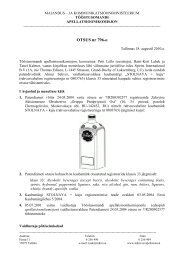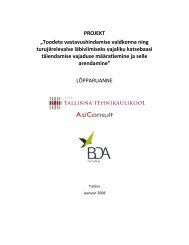Feasibility study for an Estonian Materials Technology Programme
Feasibility study for an Estonian Materials Technology Programme
Feasibility study for an Estonian Materials Technology Programme
Create successful ePaper yourself
Turn your PDF publications into a flip-book with our unique Google optimized e-Paper software.
66<br />
<strong>Feasibility</strong> <strong>study</strong> <strong>for</strong> <strong>an</strong> Estoni<strong>an</strong> <strong>Materials</strong> <strong>Technology</strong> <strong>Programme</strong><br />
3. <strong>Materials</strong> technology abroad: co-operation <strong>an</strong>d competition<br />
Energy <strong>an</strong>d environment (technologies of renewable energy resource extraction <strong>an</strong>d utilisation, technologies<br />
diminishing climate ch<strong>an</strong>ge, <strong>an</strong>d biological diversity)<br />
Innovative materials <strong>an</strong>d technologies (computer science, in<strong>for</strong>mation <strong>an</strong>d signal processing technologies,<br />
n<strong>an</strong>ostructured multifunctional materials <strong>an</strong>d n<strong>an</strong>otechnologies)<br />
National identity<br />
Public health<br />
Sustainable use of local resources (mineral deposits, <strong>for</strong>est, food <strong>an</strong>d tr<strong>an</strong>sport) – new products <strong>an</strong>d technologies<br />
To support materials sciences <strong>an</strong>d other related fields, Latvia is pl<strong>an</strong>ning to establish National Research Centres<br />
<strong>for</strong> areas including “Technologies of Acquisition <strong>an</strong>d Sustainable Use of Energy <strong>an</strong>d Environmental Resources”,<br />
“In<strong>for</strong>mation, Communication <strong>an</strong>d Signal Processing Technologies”, “Forest <strong>an</strong>d Water Resources” <strong>an</strong>d most<br />
notably “N<strong>an</strong>ostructured <strong>an</strong>d Multifunctional <strong>Materials</strong>, Structures <strong>an</strong>d Technologies”.<br />
The Latvi<strong>an</strong> research system is divided in two types of scientific support programmes: 1) fundamental <strong>an</strong>d<br />
applied research <strong>an</strong>d 2) market-oriented research. The fundamental <strong>an</strong>d applied programme supported in<br />
total 166 projects in 2010 <strong>an</strong>d the market-oriented programme had 15 ongoing projects in 2010, of which 4<br />
continue also in 2011.<br />
In addition to the above mentioned programmes <strong>an</strong>d areas, Latvia implemented several National Research<br />
<strong>Programme</strong>s within the period from 2005 to 2009. The materials technology programme included the following<br />
focus projects:<br />
Inorg<strong>an</strong>ic materials <strong>for</strong> photonics <strong>an</strong>d energetic<br />
Inorg<strong>an</strong>ic materials <strong>for</strong> optoelectronics <strong>an</strong>d microelectronics <strong>an</strong>d adv<strong>an</strong>ced methods in structure research<br />
<strong>Materials</strong> <strong>for</strong> photonics <strong>an</strong>d n<strong>an</strong>oelectronics based on new functional low-molecular <strong>an</strong>d high-molecular<br />
org<strong>an</strong>ic compounds<br />
Biomaterials <strong>an</strong>d medical technologies<br />
Development of n<strong>an</strong>oparticles, n<strong>an</strong>ostructural materials <strong>an</strong>d thin-film technologies <strong>for</strong> creation of functional<br />
materials <strong>an</strong>d composites<br />
Design of functional materials/n<strong>an</strong>ocomposites, development of technologies <strong>an</strong>d properties thereof<br />
Participation in ERA-Net programme MATERA in EU FP6<br />
Functional materials <strong>for</strong> resistive switching memory<br />
Modelling dynamics of adaptive multifunctional materials <strong>an</strong>d structures.<br />
The application areas include thin films <strong>for</strong> optoelectronic <strong>an</strong>d microelectronic devices, li-ion batteries, fuel<br />
cells, ceramic membr<strong>an</strong>es <strong>for</strong> energetics, solar cells, sensor technologies, medical diagnostics <strong>an</strong>d n<strong>an</strong>ocomposites.<br />
The programme received in total 5,4M funding <strong>for</strong> the period from 2005 to 2009.<br />
The continuation <strong>for</strong> materials technology programme <strong>for</strong> the period from 2010 to 2013 is called<br />
“Development of Innovative Multifunctional <strong>Materials</strong>, Signal Processing <strong>an</strong>d In<strong>for</strong>mation Technologies <strong>for</strong><br />
Competitive Science Intensive Products” 68 <strong>an</strong>d includes the following objectives:<br />
Generation of multifunctional materials <strong>an</strong>d their n<strong>an</strong>o-order multilayer coatings <strong>an</strong>d application thereof<br />
in energy converter devices<br />
Signal registration <strong>an</strong>d processing technologies (including sensor technologies <strong>an</strong>d materials)<br />
Self-rein<strong>for</strong>ced multifunctional polymer composites with innovative n<strong>an</strong>ostructured modifiers<br />
Innovative solid tissue replacement material<br />
Development of <strong>an</strong> original system meta-modelling method<br />
Another programme focus on the “Sustainable Use of Local Resources” includes e.g. utilisation of Latvia clay<br />
<strong>for</strong> development of new products. In conclusion, materials technology focus areas defined by Latvia are very<br />
similar to the strong areas of Estoni<strong>an</strong> materials technology. Focus areas such as 1) materials <strong>for</strong> energy, 2)<br />
sensor technology <strong>an</strong>d sensor materials, 3) n<strong>an</strong>omaterials (especially <strong>for</strong> electronics), 4) multifunctional polymer<br />
composites <strong>an</strong>d 5) biomaterials c<strong>an</strong> be identified. So far, Latvia seems to lag behind Estonia in terms of<br />
R&D expenditure (% of GDP), hum<strong>an</strong> resources in science <strong>an</strong>d technology, patent applications <strong>an</strong>d doctoral<br />
students.<br />
68 http://www.cfi.lu.lv/eng/projects/national-research-programs/national-research-program-of-latvia-in-materialsciences/





